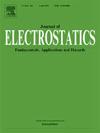均匀带电环空的静电势:空间交叉的研究
IF 2.1
4区 工程技术
Q3 ENGINEERING, ELECTRICAL & ELECTRONIC
引用次数: 0
摘要
我们提出了一个全面的性质分析静电势产生的一个均匀带电环空。环空即环形圆盘具有外半径a和内半径b=ηa的特征,其中0≤η≤1为无量纲参数,可实现圆盘(η=0)和环(η→1)之间的连续插补。目的是研究二维(圆盘状)和一维(环状)静电行为之间的几何转变。将均匀带电环空产生的静电势用第一类完全椭圆积分表示,并明确地分析了其在环空平面上的行为。我们表明,对于参数η的所有非零值,由此产生的静电势在位于环形区域内的给定径向位置上发展为明显的最大值。随着η的增大,这个峰变得更尖锐,并向外向半径移动。为了量化这种几何转变,我们分析了边缘的势作为环形厚度参数δ=a−b=(1−η)a的函数。我们的分析表明,在临界厚度δc=0.59a处,通过观察该势相对于δ的二阶导数的特征,可以确定维度交叉。δ<;δc的电位呈现正曲率,反映了在边缘附近的电荷浓度,这是均匀带电环的典型特征。相反,δ>;δc的势显示为零曲率,其特征更类似于均匀带电的圆盘。这种基于曲率的方法提供了一种物理透明和计算可访问的标准,用于区分环状和圆盘状静电行为。本文章由计算机程序翻译,如有差异,请以英文原文为准。
Electrostatic potential of a uniformly charged annulus: A study of dimensional crossover
We present a comprehensive analysis of the nature of the electrostatic potential generated by a uniformly charged annulus. The annulus, namely, the annular disk is characterized by an outer radius, and an inner radius, where is a dimensionless parameter which enables a continuous interpolation between a disk () and a ring (). The goal is to investigate the geometric transition between two-dimensional (disk-like) and one-dimensional (ring-like) electrostatic behavior. The electrostatic potential created by the uniformly charged annulus is expressed in terms of complete elliptic integrals of the first kind and we explicitly analyze its behavior on its plane. We show that for all nonzero values of parameter the resulting electrostatic potential develops a pronounced maximum at a given radial position located within the annular region. As increases, this peak becomes sharper and shifts outward towards the outer radius. To quantify this geometric transition, we analyze the potential at the edge as a function of the annular thickness parameter, . Our analysis reveals a dimensional crossover at a critical thickness identified by looking at the features of the second derivative of such potential with respect to . The potential exhibits positive curvature for reflecting a concentration of charge near the edge, typical for a uniformly charged ring. Conversely, the potential displays zero curvature for , with features that are more akin to a uniformly charged disk. This curvature-based approach offers a physically transparent and computationally accessible criterion for distinguishing between ring-like and disk-like electrostatic behavior.
求助全文
通过发布文献求助,成功后即可免费获取论文全文。
去求助
来源期刊

Journal of Electrostatics
工程技术-工程:电子与电气
CiteScore
4.00
自引率
11.10%
发文量
81
审稿时长
49 days
期刊介绍:
The Journal of Electrostatics is the leading forum for publishing research findings that advance knowledge in the field of electrostatics. We invite submissions in the following areas:
Electrostatic charge separation processes.
Electrostatic manipulation of particles, droplets, and biological cells.
Electrostatically driven or controlled fluid flow.
Electrostatics in the gas phase.
 求助内容:
求助内容: 应助结果提醒方式:
应助结果提醒方式:


